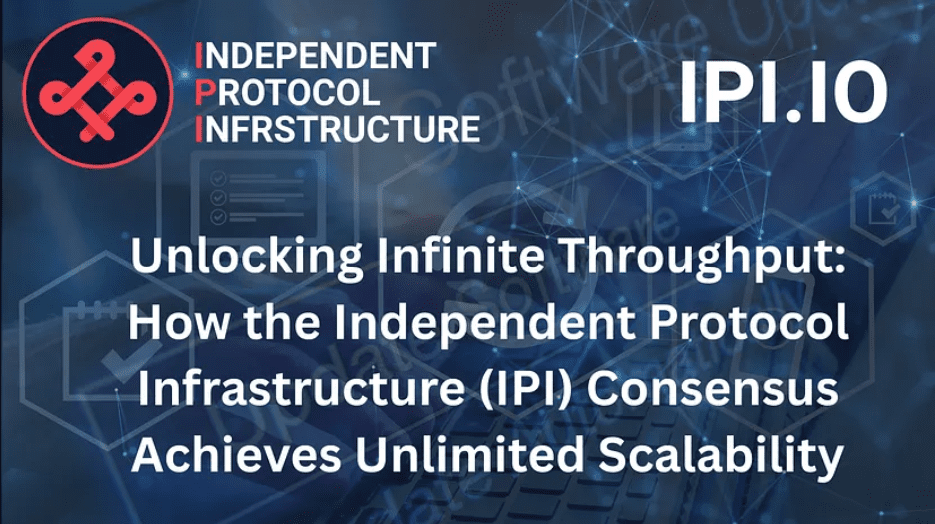IPI.io (Independent Protocol Infrastructure) presents ONEL Order Now, Execute Later: a dual-phase consensus architecture model that separates transaction ordering from execution, unlocking horizontal scalability, predictable finality, and developer-friendly smart contracts.
The Architectural Bottleneck No One Escapes
Despite a decade of research, blockchain scalability still hinges on the same trilemma: throughput versus decentralization versus security.
Monolithic designs make every node process the entire global state, creating hard throughput ceilings. Layer-2s and rollups shift load elsewhere but preserve global synchronization points. Even advanced sharding often trades composability for parallelism, complicating development.
IPI.io addresses the issue at its source — the architecture layer — with a principle drawn from computer-science reality:
Agree on order first; deterministic rules will guarantee the same result later.
This insight is formalized in ONEL: Order Now, Execute Later.
The Core Idea
If transactions are deterministic, then once the network agrees on their order, the outcome is already fixed.
Execution can safely happen in parallel, asynchronously, or on demand.
That simple shift breaks the global bottleneck.
ONEL in Practice
Phase 1 Order Now (Consensus Layer)
ONEL builds on a Proof-of-Stake foundation with VRF-based committees (Algorand-style) for proposing and validating blocks.
The network scales through adaptive, multi-level sharding arranged in a binary-tree hierarchy:
- Address-prefix sharding evenly distributes load.
- Automatic split/merge keeps shards balanced.
- Root / SubRoot chains finalize shard hashes to establish a single global order.
Validators only handle ordering, not full execution.
Local and global finality remain fast and deterministic.
Phase 2 Execute Later (Execution Layer)
Once order is fixed, execution becomes an open, distributed process:
- State lives in a K → K → V structure (Address → Key → Value).
- Transactions declare dependencies: Get, IsGreater, Set, Add, Subtract.
- Nodes or services execute only the subsets they care about.
- Thin clients verify results by fetching minimal proof chains.
Execution stays deterministic and verifiable just deferred.
The principle isn’t new: real-time multiplayer RTS games use deterministic lock-step simulation to keep thousands of players synchronized. ONEL applies the same proven logic to blockchain consensus.
Why It Matters
| Principle | Technical Effect | Real-World Benefit |
| Deterministic global ordering via PoS + VRF | Lightweight validation, predictable sequencing | Sustained high throughput without centralization |
| Declarative execution (K→K→V) | Parallelism and modular computation | Practically web-scale smart-contract capacity |
| Adaptive shard scaling | Dynamic load balancing | Stable fees and latency as demand grows |
Architecture Highlights
Sharding & Routing
Binary-tree shards split or merge automatically based on block size and validator availability.
Information moves through a topic-aware pub-sub network (mempools, proposals, votes, state queries), reducing redundant traffic.
Finality & Safety
Each shard uses VRF-selected committees for proposal → soft vote → certify vote, achieving fast Byzantine-fault-tolerant finality.
Root chains finalize shard hashes for a single coherent ledger.
Validator Economics
Rewards cascade across levels: fees flow upward, block rewards downward, with proposer incentives aligned.
Because ordering is lightweight, validator hardware can remain modest encouraging decentralization.
Censorship Resistance
Randomized selection prevents coordinated blocking: rejecting transactions would mean forfeiting rewards across multiple rounds.
Information Market
Independent execution and indexing servers deliver signed results via payment channels.
Validators can cross-check data for consistency, creating a self-correcting, reputation-based ecosystem.
Developer Experience
ONEL’s determinism makes WASM smart contracts predictable and auditable.
Explicit IN/OUT declarations replace opaque state access, simplifying debugging and security review.
To handle edge cases like dependency chains, IPI blockchain introduces commutative operations that maintain progress without breaking correctness.
Developers gain a substrate that scales with usage instead of fighting it and a runtime model they already understand from distributed systems and game engines.
Project Status
- Network: public blockchain in development, with wallet, scanner, and swap already live
- Consensus: ONEL integrating Pure PoS + VRF and multi-level sharding
- Whitepaper: “Scalability Reimagined: A Dual-Phase Architecture for Global Blockchain Adoption” (v1.0 – Jan 2025)
- Next: publish testnet benchmarks ordering latency, per-shard vs global finality, and cost-per-transaction curves alongside validator-program access
Quote placeholder: “Consensus shouldn’t be the bottleneck,” said Michael Laszczewski, CTO at IPI.io, Lead Architect at IPI.io. “By decoupling order from execution, ONEL lets performance scale like the web itself without losing the core principles of decentralization.”
Before → After → Bridge
Before: every node executes everything; global state becomes a drag on throughput.
After: deterministic global order with distributed execution; throughput grows horizontally.
Bridge: open testnet, validator cohorts, and developer previews rolling out through 2025.
That transition from serial global execution to ordered determinism defines IPI’s architectural vision for 2025 and beyond.
Explore the IPI Ecosystem
- Read the whitepaper → Deep dive into ONEL’s consensus and execution design https://www.ipi.io/ipi-consensus-whitepaper.pdf
- Explore the ecosystem → wallet | scanner | swap
About IPI.io
IPI.io (Independent Protocol Infrastructure) is developing a public blockchain built on ONEL — Order Now, Execute Later, a dual-phase consensus that separates deterministic global ordering from distributed execution.
Combining PoS with VRF committees and adaptive multi-level sharding, IPI coin targets web-scale smart-contract capacity while preserving decentralization, low fees, and predictable finality.
Website: ipi.io
Blog: blog.ipi.io
X (Twitter): x.com/ipicoin_com
Telegram: t.me/ipicoin
YouTube: youtube.com/@IpiBlockchain



































